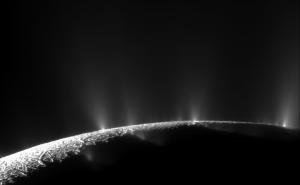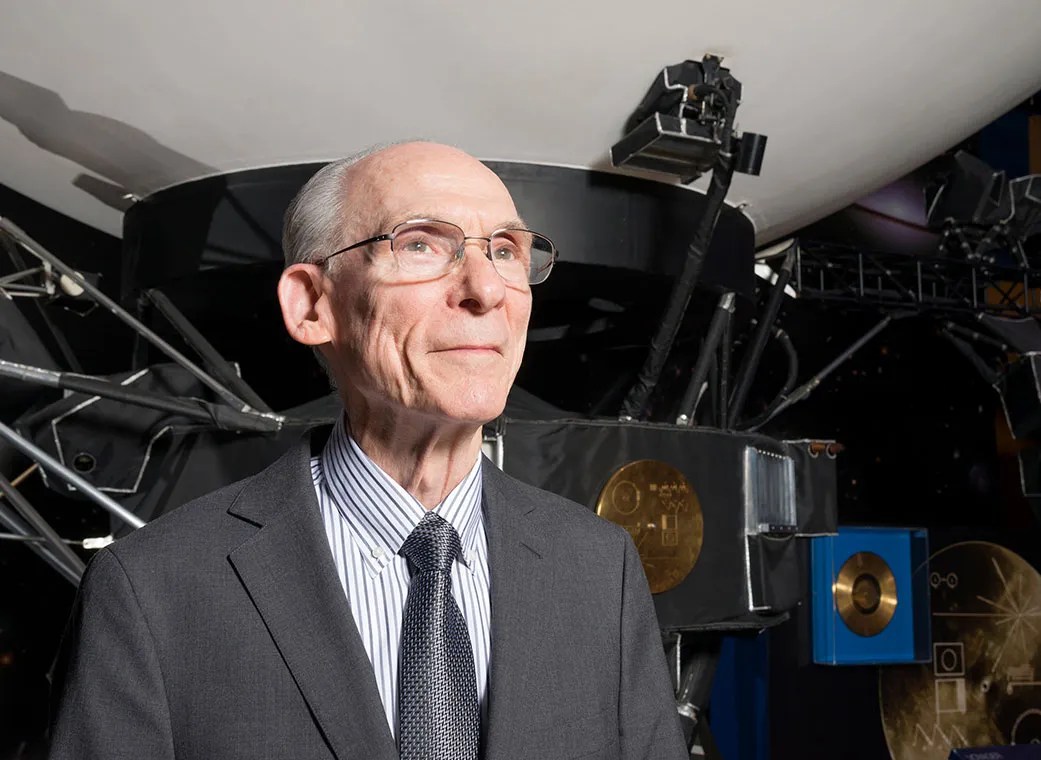Cassini Significant Events 12/28/04 – 01/05/05
January 7, 2005
(Source: Jet Propulsion Laboratory)
A Journey to Titan: The Diary Continues
Tuesday, Dec. 28:
All subsystems reported nominal spacecraft status.
The Visual and Infrared Mapping Spectrometer reported seeing about 10 minutes more heating then expected during last week’s probe release based on the results from the Kinematic Prediction Tool.
We continue to hold Command Approval Meetings (CAM) for the S07 sequences and Probe Mission sequences. S07 is different from previous sequences in that it has three background sequences – BGA, BGB, and BGC – the Probe Release sequence, Probe Relay critical sequence, a Privileged Action Program (PAP) to activate the critical sequence, two Probe relay playback sequences, five OTMs, MRE – a post-release instrument restoration sequence, MIA – the Iapetus science sequence, MPO – a post-relay orbiter instrument power-on sequence, and Satellite Orbiter Science Team sequences MS1 and MS2. Normally it’s one background sequence, a couple of minis and maybe a live update. This is a very active time for all of us!
We are holding the CAM for the MIA Iapetus science sequence today. Spacecraft Operations Office (SCO), RADAR and Science Planning will be the main contributors to the CAM.
There was a special tour science talk given today by the Huygens Project Manager. He discussed the Probe science mission and what data the on-board instruments hope to acquire.
We found out today that the Planetary Society held a contest for designing what Titan’s surface might look like. Some students from Desert Trails Elementary School in Adelanto, California, had already completed an assignment similar to this as part of the “Reading, Writing, and Rings” package and chose to submit their samples. One of the students took second place. His artwork will be displayed at the European Space Agency Headquarters in conjunction with the Huygens Mission activities this month.
Wednesday, Dec. 29:
An Integrated Test Laboratory (ITL) preparation meeting was held today for setting up the test for Orbit Trim Maneuver (OTM) 10a. All OTMs are tested in the ITL prior to uplink to the spacecraft.
The Probe Relay sequence will be CAMed tomorrow with the OTM10A Opmode transitions. (Think I’ll stop reporting CAMs. If it was uplinked to the spacecraft, you can be sure it was approved first!)
The sequence leads for S07 radiated the Iapetus MIA science sequence and an Instrument Expanded Block update for the Magnetospheric Imaging Instrument. MIA will begin execution on the 31st.
Noticed that there is a lot of new stuff posted to the Cassini website (http://saturn.jpl.nasa.gov). It seems that the program went live with a content management system (CMS) in December. This system allows for news, press releases, images, and other periodic web updates to be posted automatically. The CMS also allows for easy updating of images throughout the website, thus freeing the web development team to work on major content and design changes.
Thursday, Dec. 30:
The Iapetus mini-sequence began execution. Tomorrow is the big day, the actual flyby.
The sequence leads sent up commands today to power on the supplemental heater for the Cassini Plasma Spectrometer (CAPS). The instrument was cooling down more than desired. Both Spacecraft (S/C) Thermal and CAPS subsystems later verified that the supplemental heater did turn on. All is well with the instrument.
Radio and Plasma Wave Science instrument personnel reported seeing noise during Probe Release. The noise has been attributed to a chopper power supply in the PSU. PWR and RWPS subsystems were able to compare several other pyro events and confirmed the noise was from the Pyro subsystem.
All S/C subsystems are nominal.
ITL will be running OTM 10a tonight.
Friday, Dec. 31:
Today is a JPL holiday, the day before New Years. There are no status meetings or reports for today. This is where the engineering side of the team steps down and science takes center stage! Today and tomorrow it’s all about IAPETUS!
The Cassini spacecraft flew over Iapetus today at a distance of about 123,390 kilometers. Closest approach occurred over the moon’s dark hemisphere, which has never been seen at close range. This was the first close encounter of the satellite in our tour. The next — and last — is in 2007.
Iapetus is Saturn’s third largest moon with a diameter of about 1500 km. It is the only large Saturn moon in a highly inclined orbit. This takes it far above and below the plane in which the rings and most of the moons orbit.
Iapetus was last observed by NASA’s Voyager 1 and 2 spacecraft in 1980 and 1981. Cassini got about ten times closer than Voyager 2. The best images taken by Voyager had a resolution of about 8km per pixel. On this pass Cassini got down to a resolution of about 1km per pixel. An important science objective of our mission is to understand the mysterious albedo dichotomy that dominates the appearance of Iapetus, with one hemisphere coal-black and one hemisphere quite bright and ice-rich.
Spectra and images were taken by all remote-sensing instruments and by RADAR to characterize the history and composition of the satellite. Raw images from the Iapetus flyby are available at: http://saturn.jpl.nasa.gov/multimedia/images/raw .
Saturday, Jan. 1, 2005!
JPL and Caltech’s float in the 2005 Tournament of Roses Parade titled “Family of Explorers” was a transformer toy-looking figure comprised of nine of the lab’s missions. With sound effects, music, strobe lights, and a rocket pack that blasts smoke, the “rocket man” is designed to remind onlookers of JPL’s successes from 2004. At 15 meters in height, it was the tallest float in the parade. Most importantly, at least to members of this flight team, the Cassini Saturn orbiter was at the pinnacle atop the robot’s helmet.
I should have reported this last week. It feels more like a Christmas present than a New Years report. In 2005 Cassini will have 13-targeted encounters with five of Saturn’s moons. Eight of our 13 close flybys will be of Titan with a number of more distant flybys of the icy satellites, and Saturn and the rings each time we come around! Here is a list of the Cassini spacecraft targeted satellite encounters for 2005:
Titan: Jan. 14, 2005
Titan: Feb. 15, 2005
Enceladus: March 9, 2005
Titan: March 31, 2005
Titan: April 16, 2005
Enceladus: July 14, 2005
Titan: Aug. 22, 2005
Titan: Sept. 7, 2005
Hyperion: Sept. 26, 2005
Dione: Oct. 11, 2005
Titan: Oct. 28, 2005
Rhea: Nov. 26, 2005
Titan: Dec. 26, 2005
The Iapetus mini-sequence will be finishing up tonight.
All S/C subsystems are nominal.
ITL reported that the OTM 10A maneuver test went well. The test run is complete and data is available for ACS Uplink to review. There was no unexpected fault protection seen.
Sunday, Jan. 2:
We loaded the Probe Relay critical sequence today and verified that it had registered on both strings.
ACS has reviewed the results from yesterday’s ITL run. Looks good.
Monday, Jan. 3:
Uplinked the Activation PAP for the Probe Relay sequence.
Uplinked and successfully executed the OTM 10A maneuver today. This maneuver, also called the Orbiter Deflection Maneuver Clean-Up, further refines Cassini’s trajectory in preparation for the Huygens probe mission on Jan. 14.
The reaction control system (RCS) burn began at 4:45 p.m. PST. A “quick look” immediately after the maneuver showed the burn duration was 147.6 sec, giving a delta-V of approximately 140 mm/s. This was the first RCS OTM since the Huygens probe separation on Dec. 24.
All subsystems reported nominal after the maneuver.
A revalidated waypoint analysis was performed for S09. There was concern that problems might have been introduced with the release of a new reference trajectory. The sequence lead for S09 reported no problems found. The Sub Sequence Generation phase for S09 completed today.
Tuesday, Jan. 4:
Today we uplinked the first of two Probe Relay playback sequences, an Immediate/Delayed Action Program to snap the partition 6 SSR Record Pointers, and the S07 BGB background sequence.
All S/C subsystems are nominal.
A command moratorium went into effect at noon today. This means that all unplanned sequences must be accompanied with a Command Lost Timer reduction command. The ACE will not need to send 6NOP commands until Jan. 14.
There was a discussion regarding late updates to the Science mini-sequences MS1 and MS2. MS1 and MS2 should use OTM 10A predicts. SCO will not be able to support an update based on OTM 11 predicts.
Wednesday, Jan. 5:
Today was a quiet day for the S/C.
All S/C subsystems are nominal. There are no changes in alarm status.
The sequence lead for S08 reported that the Radio Science Subsystem (RSS) Inertial Vector Definition end-to-end test with Fit Accuracy fix was performed in ITL. The test was successful. We now have a working solution that satisfies RSS requirements and without sequence violations.
The most recent spacecraft telemetry was acquired from the Goldstone tracking station on Monday, Jan. 5. The Cassini spacecraft is in an excellent state of health and is operating normally.
As of today, Jan. 5, the Program is nine days from Probe relay.
































